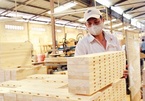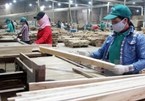Nguyen Liem, general director of Binh Duong-based Lam Viet JSC, when attending the conference last week in Hanoi, received an urgent call from his company.

The company's containers of wooden products to be shipped to the US have had to undergo red-channel customs inspection.
Under current regulations, exports are classified into three types according to the degree of risk: green, yellow or red channel. Of these, the clearance of goods via red channel takes longest time. Goods owners have to show many kinds of documents, and goods have to undergo strict physical inspection.
| The red-channel customs inspection is applied not only to Lam Viet, which exports 200 containers of products to the US each month, but to all wooden export products in an effort to prevent trade fraud. |
The red-channel customs inspection is applied not only to Lam Viet, which exports 200 containers of products to the US each month, but to all wooden export products in an effort to prevent trade fraud.
Vietnam has been warned that Chinese enterprises may use phony Vietnamese origin for their exports to the US in order to avoid heavy tax. Therefore, customs agencies have been requested to reinforce the inspection over imports and exports to fight against origin counterfeiting and violations in labeling.
Liem complained that the new regulation will increase the cost higher, and the enterprise is at risk of being fined by US importers because of the delay in delivery.
Nguyen Sy Hoe, deputy director of Phu Tai, said that requiring woodwork exports to undergo red-channel customs inspection is not a good solution to reach two targets.
It is important to prevent Chinese enterprises from counterfeiting Vietnamese origin to export their products to the US market.
The possibility of the US government imposing trade sanctions on Vietnam’s exports should be reduced.
Hoe said Phu Tai’s target of obtaining revenue of $40 million a year is challenging and this depends on the inspection of every container of export products. It’s not easy to export woodwork to the US at this moment as the US government has tightened regulations on importing products since the US-China trade war breakout.
Analysts said Vietnam has great opportunities to boost woodwork exports to the US and gain bigger market share there, but it is facing big challenges because of the production shift by Chinese enterprises.
According to Huynh Van Hanh, deputy chair of the Handicraft and Wood Industry Association of HCM City (HAWA), large Chinese enterprises are not likely to relocate production to Vietnam because of high costs which cannot be offset by profits.
However, Vietnam may suffer from production shift by Chinese small enterprises which have small investment scale and equipment that has fully depreciated.
Chi Mai

Vietnam needs ‘FDI filter’ for woodwork industry
The US-China trade war has led toChinese wooden furniture manufacturers moving production to Vietnam, bringing risks to the domestic woodwork industry.

Vietnamese woodworking firms increase investment in technology, machinery
Nguyen Phuong, sales director of Minh Thanh Co., Ltd, said his company plans to invest more than 50 billion VND (2.15 million USD) in a production chain for bedroom and living room furniture.
 The new regulation on certificate of origin (C/O) makes it more for Vietnam to obtain $11 billion in woodwork exports this year as planned.
The new regulation on certificate of origin (C/O) makes it more for Vietnam to obtain $11 billion in woodwork exports this year as planned.